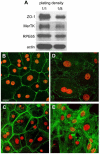Understanding photoreceptor outer segment phagocytosis: use and utility of RPE cells in culture
- PMID: 24780752
- PMCID: PMC4145030
- DOI: 10.1016/j.exer.2014.01.010
Understanding photoreceptor outer segment phagocytosis: use and utility of RPE cells in culture
Abstract
RPE cells are the most actively phagocytic cells in the human body. In the eye, RPE cells face rod and cone photoreceptor outer segments at all times but contribute to shedding and clearance phagocytosis of distal outer segment tips only once a day. Analysis of RPE phagocytosis in situ has succeeded in identifying key players of the RPE phagocytic mechanism. Phagocytic processes comprise three distinct phases, recognition/binding, internalization, and digestion, each of which is regulated separately by phagocytes. Studies of phagocytosis by RPE cells in culture allow specifically analyzing and manipulating these distinct phases to identify their molecular mechanisms. Here, we compare similarities and differences of primary, immortalized, and stem cell-derived RPE cells in culture to RPE cells in situ with respect to phagocytic function. We discuss in particular potential pitfalls of RPE cell culture phagocytosis assays. Finally, we point out considerations for phagocytosis assay development for future studies.
Keywords: engulfment; phagocytosis; photoreceptor outer segment renewal; retinal pigment epithelium; signaling.
Copyright © 2014 Elsevier Ltd. All rights reserved.
Figures



Similar articles
-
Molecular characterization and functional analysis of phagocytosis by human embryonic stem cell-derived RPE cells using a novel human retinal assay.Mol Vis. 2009;15:283-95. Epub 2009 Feb 6. Mol Vis. 2009. PMID: 19204785 Free PMC article.
-
Diurnal Photoreceptor Outer Segment Renewal in Mice Is Independent of Galectin-3.Invest Ophthalmol Vis Sci. 2021 Feb 1;62(2):7. doi: 10.1167/iovs.62.2.7. Invest Ophthalmol Vis Sci. 2021. PMID: 33538769 Free PMC article.
-
Semaphorin4D-PlexinB1 Signaling Attenuates Photoreceptor Outer Segment Phagocytosis by Reducing Rac1 Activity of RPE Cells.Mol Neurobiol. 2018 May;55(5):4320-4332. doi: 10.1007/s12035-017-0649-5. Epub 2017 Jun 17. Mol Neurobiol. 2018. PMID: 28624895 Free PMC article.
-
Mechanism of Photoreceptor Outer Segment Tip Ingestion: Evidence of Trogocytosis.Adv Exp Med Biol. 2025;1468:309-311. doi: 10.1007/978-3-031-76550-6_51. Adv Exp Med Biol. 2025. PMID: 39930214 Review.
-
Animal Models, in "The Quest to Decipher RPE Phagocytosis".Adv Exp Med Biol. 2014;801:77-83. doi: 10.1007/978-1-4614-3209-8_10. Adv Exp Med Biol. 2014. PMID: 24664683 Review.
Cited by
-
Circadian regulation in the retina: From molecules to network.Eur J Neurosci. 2020 Jan;51(1):194-216. doi: 10.1111/ejn.14185. Epub 2018 Oct 24. Eur J Neurosci. 2020. PMID: 30270466 Free PMC article. Review.
-
Degradation of Photoreceptor Outer Segments by the Retinal Pigment Epithelium Requires Pigment Epithelium-Derived Factor Receptor (PEDF-R).Invest Ophthalmol Vis Sci. 2021 Feb 1;62(2):30. doi: 10.1167/iovs.62.2.30. Invest Ophthalmol Vis Sci. 2021. PMID: 33605986 Free PMC article.
-
Large-scale purification of porcine or bovine photoreceptor outer segments for phagocytosis assays on retinal pigment epithelial cells.J Vis Exp. 2014 Dec 12;(94):52100. doi: 10.3791/52100. J Vis Exp. 2014. PMID: 25548986 Free PMC article.
-
Shedding of ciliary vesicles at a glance.J Cell Sci. 2022 Oct 1;135(19):jcs246553. doi: 10.1242/jcs.246553. Epub 2022 Oct 12. J Cell Sci. 2022. PMID: 36222105 Free PMC article.
-
Cell-autonomous lipid-handling defects in Stargardt iPSC-derived retinal pigment epithelium cells.Stem Cell Reports. 2022 Nov 8;17(11):2438-2450. doi: 10.1016/j.stemcr.2022.10.001. Epub 2022 Oct 27. Stem Cell Reports. 2022. PMID: 36306781 Free PMC article.
References
-
- Ahmado A, Carr AJ, Vugler AA, Semo M, Gias C, Lawrence JM, Chen LL, Chen FK, Turowski P, da Cruz L, Coffey PJ. Induction of differentiation by pyruvate and DMEM in the human retinal pigment epithelium cell line ARPE-19. Invest. Ophthalmol. Vis. Sci. 2011;52:7148–7159. - PubMed
-
- Albert DM, Tso MO, Rabson AS. In vitro growth of pure cultures of retinal pigment epithelium. Arch. Ophthalmol. 1972;88:63–69. - PubMed
-
- Besharse JC, Hollyfield JG, Rayborn ME. Photoreceptor outer segments: accelerated membrane renewal in rods after exposure to light. Science. 1977;196:536–538. - PubMed
-
- Bobu C, Hicks D. Regulation of retinal photoreceptor phagocytosis in a diurnal mammal by circadian clocks and ambient lighting. Invest. Ophthalmol. Vis. Sci. 2009;50:3495–3502. - PubMed
Publication types
MeSH terms
Grants and funding
LinkOut - more resources
Full Text Sources
Other Literature Sources

